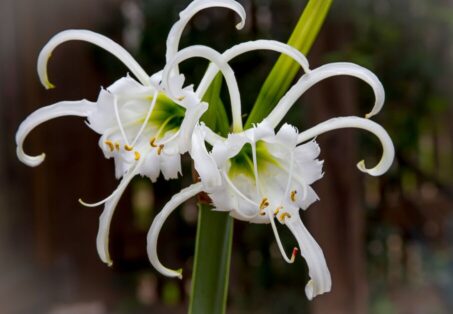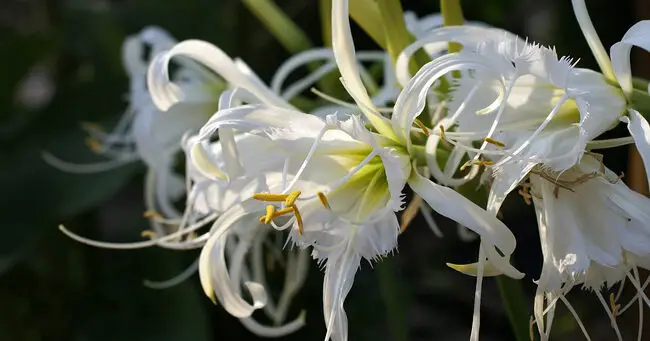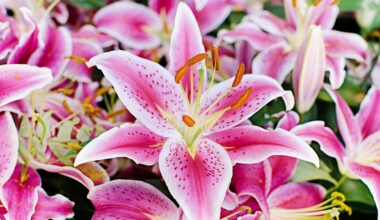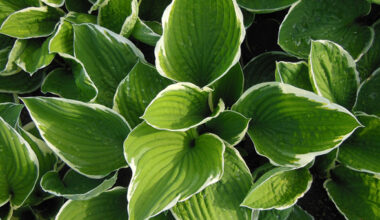The Peruvian daffodil forms beautiful tufts of shiny dark green oblong leaves that can reach 30 inches in length and bloom from May to July erect stems bearing umbels of 2 to 5 flowers in wide white cups with long narrow petals that gave it its vernacular name of “spider lily” (also Peruvian daffodil). These flowers which can reach 6 inches in diameter are deliciously fragrant.
Ismene x festalis otherwise called “Peruvian daffodil” or “spider lily” is a bulbous plant belonging to the Amaryllidaceae family. It is a hybrid of horticultural origin with white flowers, resulting from the crossing between Ismene longipetala and Ismene narcissiflora.
Contents
Why You Should Plant Peruvian Daffodils
The perfume of the Peruvian daffodil makes this plant an ideal subject to install very close to an entrance, under a window, or in pot on a balcony or a terrace. In rockeries, but also in center of massif, this bulb of end of spring or summer also makes its effect accompanied by flowered perennials like lavenders, gauras or even bush roses with which it marries perfectly.
On a large terrace, an alley made up of potted agapanthus and Peruvian daffodil will attract all eyes if you manage to find the species that bloom at exactly the same time! The flowers of the Peruvian daffodil can also be used in bouquets because they have a good holding in vase.
Collectors will be able to have fun by getting other species or cultivars like the famous ‘Sulphur Queen’ with yellow flowers.
Where and when to plant?
To best adapt the Peruvian daffodil in your garden, take inspiration from its natural environment, rocky meadows in the warm regions of America. Peruvian daffodils appreciate a well-drained, humus-rich, sandy and not very fertile soil. Beware of excess water that would rot the bulb.
If you plant your Peruvian daffodils in a pot, the ideal substrate will be a mixture of soil, garden soil and river sand in proportion of one third.
The Peruvian daffodils are very frosty, it is thus necessary to wait until the last risks of frost are removed before planting. A plantation in May is ideal. In full ground, the Peruvian daffodils are to be cultivated like Gladioli by taking them out of the ground before the first frosts. They will also enjoy themselves in a winter garden, a veranda or any other place sheltered from the risks of frost.
To slightly hasten the blooming, you can also choose to plant one earlier (during April) in a pot inside and then move the pot outside when the good weather arrives.
How to plant it?
Plant the Peruvian daffodil in groups of three for a beautiful effect from the first year. It takes 8 to 9 bulbs to decorate a massif of 10 square feet. Buy large bulbs, of a size higher than 6 inches: guarantee of several floral stems.
For a culture in full ground, work the ground in depth and improve the drainage by amending it with quite ripe compost, compost of good quality and gravels if it is of compact nature. Bury the bulbs 4-6 inches deep and 8 inches apart.

How to plant the Peruvian daffodil in a pot?
Place only one bulb per pot with a diameter less than or equal to 8 inches. For three bulbs, plan a pot of at least 15 inches in diameter.
Use a rich substrate, lightened with perlite or vermiculite, like compost for pelargoniums. Place a layer of clay balls 1/5 the height of the pot.
Bury the bulbs under 2 to 4 inches of potting soil. Push in a few cones of long-lasting fertilizer (6 months) to avoid summer fertilization. Keep the pot indoors until May, in cold regions.
Maintenance of the Peruvian daffodil
Free of disease and pests (with a few exceptions), Peruvian daffodils are relatively easy to care for.
During the growth phase, and even more so during blooming, it is necessary to water regularly to prevent the bulb from drying out. Water abundantly but let the soil dry out between waterings to prevent the bulb from rotting. After blooming, stop watering to encourage the bulb to go into dormancy.
After blooming, remove the flower stems to prevent the bulb from going to seed and help the bulb to replenish its reserves. Attention, do not cut the foliage immediately but wait until it is completely yellowed (it is essential for the plant to store nutrients for the next season). You can also add bulb fertilizer after blooming.
In the autumn, before the first frosts, pull out the bulbs and store them during the winter. Leave them to rest throughout the winter, dry and frost-free at a temperature between 45 and 55 fahrenheit.
In greenhouses or verandas, whitefly attacks are possible, especially if the weather is warm. You can take your plants out of the greenhouse or aerate to chase these small pests away to more favourable temperatures. Spray with a mixture of water and black soap (paying special attention to the underside of the leaves which whiteflies are particularly fond of) or test our associations to keep whiteflies away.
Summary
The Peruvian daffodil is a bulbous plant with a vigorous foliage in tufts of green and shiny ribboned leaves measuring up to 9 inches high. The leaves come out in spring and disappear if there is a light frost in autumn, the blooming takes place from May to July.
In areas where they do not freeze, they can be persistent. At the end of spring, or early summer, a high flower spike produces 2 to 5 white flowers with green streaks.









